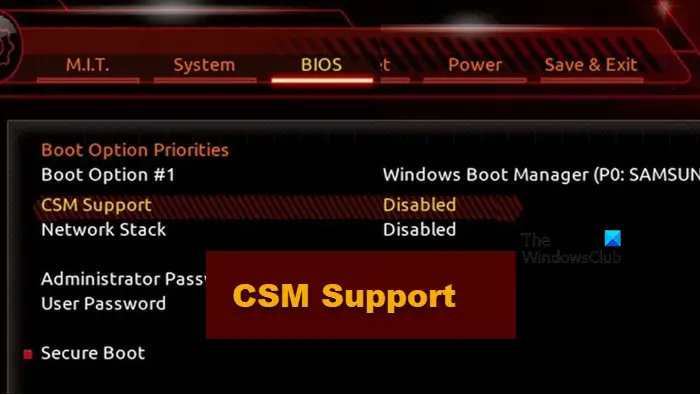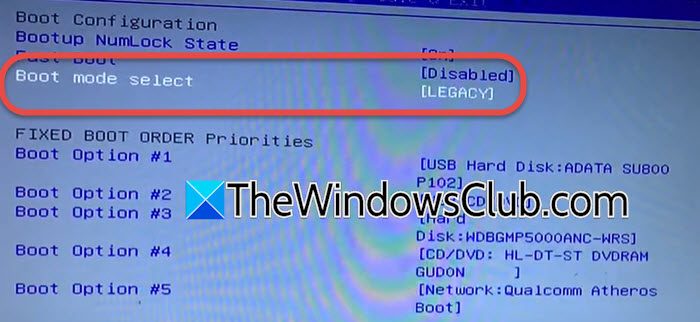CSM or Compatibility Support Mode is a part of UEFI Firmware and is used to make an operating system and other connected devices compatible with the UEFI. It is only used by devices when the application is not compatible with BIOS but UEFI. In this post, we will learn what is CSM Support in BIOS and how you can enable or disable it.
What is CSM Support? Should I enable or disable it?
CSM Support allows older systems to be compatible with the newer ways of booting up, which is nothing but UEFI. UEFI, as you may already know, is an advanced version of BIOS and is much faster than it.
In case, the device, operating system, or application that you are using is not compatible with BIOS, you would need to enable it. However, if there is no such device, you should disable the CSM Support. Ideally, there should be no need to disable the feature, but in some cases, CSM Support tends to interfere with the operating system and cause problems.
Therefore, you need to turn off CSM BIOS in case you want to install an operating system that only supports UEFI. For all Windows from 8 to 11, you need to use UEFI only.
Legacy or CSM boot support in Windows 11
Legacy refers to the old BIOS system that has been used in computers for many years to start the computer and allow hardware and software to communicate. CSM Support is a feature within the newer UEFI system that allows the computer to run in legacy BIOS mode, ensuring compatibility with older operating systems and hardware. So, while Legacy Support is the older system, CSM Support in UEFI helps newer computers remain compatible with older systems.
You will need to disable CSM BIOS mode if you are installing an OS that only supports UEFI (such as Windows 8 or later). Windows 11 needs Secure Boot and that is only available in UEFI Mode. If you need to use older hardware, operating systems, or applications, you must enable the Compatibility Support Module (CSM).
Disable or Enable CSM Support in BIOS in Windows 11/10
We are going to learn how to enable or disable CSM Support in BIOS for the following motherboards, but before that, you must boot into BIOS.
- Configure CSM Support in Asus Motherboard
- Configure CSM Support in Gigabyte Motherboard
- Configure CSM Support in ASRock Motherboard
- Configure CSM Support in MSI Motherboard
Let us talk about them in detail.
1] Configure CSM Support in Asus Motherboard

Let us first start with one of the most famous system manufacturers, Asus. If you have an Asus computer, follow the steps mentioned below to disable CSM Support.
- After booting your computer in BIOS, navigate to the Boot tab, you need to use the arrow key to navigate as on some occasions, a mouse pointer might not be available.
- Then navigate to the CSM (Compatibility Support Module) section.
- Look for Launch CSM and then set it to Disable. If you want to turn it on, just enable it.
- Finally, press Save and Exit.
This will do the job for you.
2] Configure CSM Support in Gigabyte Motherboard

If you have a Gigabyte system, follow the steps mentioned below to configure CSM Support.
- In BIOS, go to BIOS or the Security tab.
- Go to CSM Support.
- Now, set it to Enabled or Disabled.
- Finally, go to the Power tab and then Save & Exit.
This should do the job for you.
3] Configure CSM Support in ASRock Motherboard
ASRock users can use the following steps mentioned below to configure the CSM Support option.
- First launch your computer in Boot/UEFI.
- Now, go to the Boot tab.
- Then navigate to the CSM option and then configure it to the state you want.
- Finally, go to the Exit tab and then save and exit it.
That’s how you can configure CSM on the ASRock motherboard.
4] Configure CSM Support in MSI Motherboard

You can follow the steps mentioned below to configure CSM Support in MSI Motherboard.
- Once your computer boots up the BIOS mode, you need to go to the Boot tab.
- Now, navigate to Boot Mode and then select the UEFI only option. This will disable CSM boot.
- Finally, hit the F10 key to save the alteration you made and exit BIOS.
That’s how you can configure CSM Support in MSI Motherboard.
That’s it!
Read: Recover forgotten Windows passwords with PCUnlocker
What happens if I disable CSM support?
If you disable CSM Support, UEFI support will be enabled on your motherboard. However, since most of them are not running Windows 7 or any operating system prior to Windows 8, there is actually no harm in disabling CSM Support. In fact, it is better to keep it disabled because otherwise, it can cause conflict.
Read: What is Windows WHQL Setting in the BIOS?
Why can’t I boot if I disable CSM?
When Windows is installed using BIOS, it requires BIOS support to boot, but converting MBR to GPT allows for UEFI usage. However, before that, you must update your BIOS. In case, BIOS update is to no avail, then only convert MBR to GPT.
Read Next: System doesn’t have any USB boot option error in Windows.
Leave a Reply